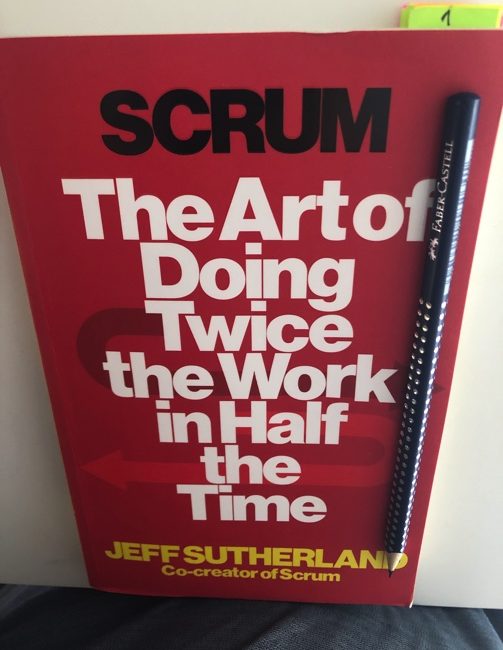Scrum: The Art of Doing Twice the Work in Half the Time – Jeff Sutherland

Here are my notes from the practical book Scrum: The Art of Doing Twice the Work in Half the Time.
Several of us were reading it as a part of a ‘smaller book club’ and we all echoed the same feeling about the book: we love it and will not only look to apply it in the work environment but also at home in our personal lives.
Ingredients for scrum
- Product Owner
- What and Why needs to be done
- Knows the market, the customer and has a vision
- Team (3-9 people)
- Decide on the Who and How
- Scrum Master
- Coaches the Scrum framework and removes waste
- Create and prioritize the Backlog
- Constantly evolving
- Refine and estimate the Backlog
- Planning Poker with Fibonacci sequence
- Sprint planning
- Team, Scrum Master, and the Product Owner
- Always of fixed length (from 1 to 4 weeks in general)
- Velocity
- Sum of points done in one Sprint
- Sprint goal
- Everyone has to agree on one sprint goal in the Sprint
- Scrum board
- Has lanes ToDo, Doing, Done (we use Clubhouse)
- Burndown chart
- Chart showing a number of points done per day
- Daily Stand-up or Daily Scrum
- 15 min max meeting where you answer three questions:
- What did you do yesterday to help the team finish the Sprint?
- What will you do today to help the team finish the Sprint?
- Is there any obstacle blocking you or the team from achieving the Sprint goal?
- 15 min max meeting where you answer three questions:
- Sprint review or Sprint demo
- Show what was done in a Sprint
- Show what’s totally finished by the DoD (Definition of Done)
- Show what was done in a Sprint
- Sprint retrospective
- What went right?
- What could have gone better?
- What is the improvement in the process that we as a team can implement right away (in the next Sprint)?
- The process should be blameless – we’re looking at the process, not people!
Takeaways per chapter
- CH #1 – The way the world works is broken
- Planning is useful. Blindly following plans is stupid.
- It’s just too tempting to draw up endless charts. All the work needed to be done on the massive project laid out for everyone to see – but when detailed plans meet reality, they fall apart. Build into your working method the assumption of change, discovery, and new ideas.
- Inspect and adapt
- Every little while, stop doing what you’re doing, review what you’ve done, and see if it’s still what you should be doing and if you can do it better.
- Change or die
- Clinging to the old way of doing things, of command and control and rigid predictability, will only bring failure. In the meantime, the competition that is willing to change will leave you in the dust.
- Fail fast so you can fix early
- Corporate culture often puts more weight on forms, procedures, and meetings than on visible value creation that can be inspected at short intervals by users. Work that does not produce real value is madness. Working product in short cycles allows early user feedback and you can immediately eliminate what is obviously wasteful effort.
- Planning is useful. Blindly following plans is stupid.
- CH #2 – the origins of Scrum
- Hesitation is death
- Observe, Orient, Decide, Act. Know where you are, assess your options, make a decision, and act!
- Look outward for answers
- Complex adaptive systems follow a few simple rules, which they learn from their environment.
- Great teams are
- They are cross-functional, autonomous, and empowered with a transcendent purpose.
- Don’t guess. Plan, Do, Check, Act.
- Plan what you’re going to do. Do it. Check whether it did what you wanted. Act on that and change how you’re doing things. Repeat in regular cycles, and, by doing so, achieve continuous improvement.
- Shu Ha Ri
- First, learn the rules and the forms, and once you’ve mastered them, making innovations. Finally, in a heightened state of mastery, discard the forms and just be – with all the learning internalized and decisions made almost unconsciously.
- Hesitation is death
- CH #3 – Teams
- Pull the right lever
- Change team performance. That has much more impact – by several orders of magnitude – than individual performance.
- Transcendence
- Great teams have a purpose that is greater than the individual; e.g. burying General MacArthur, winning the NBA championship.
- Autonomy
- Give teams the freedom to make decisions on how to take action – to be respected as masters of their craft. The ability to improvise will make all the difference, whether the unit is reporting on a revolution in the Middle East or making the sale.
- Cross-functional
- The team must have every skill needed to complete a project, whether the mission is to deliver Salesforce.com software or capture terrorists in Iraq.
- Small Wins
- Small teams get work done faster than big teams. The rule of thumb is 7 members ± 2. Err on the small side.
- Blame is stupid
- Don’t look for bad people; look for bad systems – one that incentivizes bad behavior and rewards poor performance.
- Pull the right lever
- CH #4 – Time
- Time is finite. Treat it that way.
- Break down your work into what can be accomplished in a regular, set, short period – optimally 1 to 4 weeks. And if you’ve caught the Scrum fever, call at the Sprint.
- Demo or die
- At the end of each sprint, have something that it’s done – something that can be used (to fly, drive, whatever)
- Throw away your business cards
- Titles are specialized status markers. Be known for what you do, not how you’re referred to.
- Everyone knows everything
- Communication saturation accelerates work.
- One meeting a day
- When it comes to team check-ins, once a day is enough. Get together for 15 minutes at the daily standup, see what can be done to increase speed, and do it.
- Time is finite. Treat it that way.
- CH #5 – Waste is a crime
- Multitasking makes you stupid
- Doing more than one thing at a time makes you slower and worse at both tasks. Don’t do it. If you think this doesn’t apply to you, you’re wrong – it does.
- Half-done is not done
- A half-built car simply ties up resources that could be used to create value or save money. Anything that’s “in process” costs money and energy without delivering anything.
- Do it right the first time
- When you make a mistake, fix it right away. Stop everything else and address it. Fixing it later can take you more than 20 times longer than if you fix it now.
- Working too hard only makes more work
- Working long hours doesn’t get more done; it gets less done. Working too much results in fatigue, which leads to errors, which leads to having to fix the thing you just finished. Rather than work late or on weekends, work weekdays only at a sustainable pace. And take a vacation.
- Don’t be unreasonable
- Goals that are challenging our motivators; goals that are impossible are just depressing.
- No heroics
- If you need a hero to get things done, you have a problem. Heroic effort should be viewed as a failure of planning.
- Enough with the stupid policies
- Any policy that seems ridiculous likely is. Stupid forms, stupid meetings, stupid approvals, stupid standards are just that – stupid. If your office seems like a Dilbert cartoon, fix it.
- No assholes
- Don’t be one, and don’t allow the behavior. Anyone who causes emotional chaos, inspires fear or dread, or demeans or diminishes people needs to be stopped cold.
- Strive for flow
- Choose the smoothest, most trouble-free way to get things done. Scrum is about enabling the most flow possible.
- Multitasking makes you stupid
- CH #6 – Plan reality, not fantasy
- The map is not the terrain
- Don’t fall in love with your plan. It’s almost certainly wrong.
- Only plan what you need to do
- Don’t try to project everything else years in advance. Just plan enough to keep your teams busy.
- What kind of dog is it?
- Don’t estimate in absolute terms like hours – it’s been proven that humans are terrible at that. Size things relatively, by what breed of dog the problem is, or T-shirt size, or, more commonly, the Fibonacci sequence.
- Ask the Oracle
- Use a blank technique, like the Delphi method, to avoid anchoring biases such as the halo effect or bandwagon effect or just plain stupid groupthink.
- Planing poker
- Use planning poker to quickly estimate the work that needs to be done.
- Work is a story
- Think first about who will be getting value from something, then about what it is, and then why do you need it. Humans think in narratives, so give them one. As an X, I want Y, so that Z.
- Know your velocity
- Every team should know exactly how much work they can get done in each Sprint. And they should know how much they can improve that velocity by working smarter and removing barriers that are slowing them down.
- Velocity x Time = Delivery
- Once you know how fast you’re going, you’ll know how soon you’ll get there.
- Set audacious goals
- With Scrum it is not that hard to double production or cut on delivery time in half. If you do it the right way, your revenue and stock price should double as well.
- The map is not the terrain
- CH #7 – Happiness
- It’s the journey, not the destination
- True happiness is found in the process, not the result. often we only reward the results, but what we are really want to reward his people striving towards greatness.
- Happy is the new black
- It helps you make smarter decisions. Plus, when you’re happy, you’re more creative, less likely to leave your job, and more likely to accomplish far more than you’ve ever anticipated.
- Quantify happiness
- It’s not enough to just feel good; you need to measure that feeling and compare it to actual performance. Other metrics look backward. Happiness is the future-looking metric.
- Get better every day – and measure it
- At the end of each Sprint, the team should pick one small improvement, or kaizen, that will make them happier. And that should become the most important thing they’ll accomplish in the next Sprint.
- Secrecy is poison
- Nothing should be secret. Everyone should know everything, and that includes salaries and financials. Obfuscation only serves people who serve themselves.
- Make work visible
- Have a board that shows all the work that needs to be done, what is being worked on, and what is actually done. Everyone should see it, and everyone should update it every day.
- Happiness is autonomy, mastery, and purpose
- Everyone wants to control their own destiny, and get better at what they do, and serve a purpose greater than themselves.
- Pop the happy bubble
- Don’t get so happy that you start believing your own bullshit. Make sure happiness is measured against performance and if there is a disconnect, be prepared to act. Complacency is the enemy of success.
- It’s the journey, not the destination
- CH #8 – Priorities
- Make a list. Check it twice.
- Create a list of everything that could possibly be done on the project. Then prioritize it. Put the items with the highest value and lowest risk at the top of the backlog, then the next, and then the next.
- The Product owner
- She translates vision into Backlog. She needs to understand the business case, the market, and the customer.
- Has knowledge of the domain and the power to make final decisions. Is available to answer questions and is accountable for delivering value.
- A leader isn’t a boss
- A product owner sets out what needs to be done and why. How the team accomplishes it and who accomplishes it is up to the team.
- Observe, Orient, Decide, Act (OODA)
- See the whole strategic picture, but act tactically and quickly
- Fear, uncertainty, and doubt
- It’s better to give than to receive. Get inside your competitors OODA loop and wrap them up in their own confusion.
- Get your money for nothing and your change for free
- Create new things as long as those new things deliver value all stop be willing to swap them out for things that require equal effort. What in the beginning you thought you needed is never what is actually needed.
- Make a list. Check it twice.
- CH #9 – Change the world
- Scrum accelerates all human endeavors
- The type of project or problem doesn’t matter – Scrum can be used in any endeavor to improve performance and results
- Scrum for schools
- In the Netherlands, a growing number of teachers are using Scrum to teach high school. They see an almost immediate improvement in test scores of more than 10%. And they’re engaging all sorts a few students, from vocational to gifted.
- Scrum for poverty
- In Uganda, the Grameen Foundation is using Scrum to deliver agricultural and market data to poor rural farmers. The result: double the yield and double the revenue for some of the poorest people on the planet.
- Rip up your business cards
- Get rid of old titles, all managers, all structures. Give people the freedom to do what they think best and the responsibility to be accountable for it. You’ll be surprised at the results.
- Scrum accelerates all human endeavors





Leave a Comment